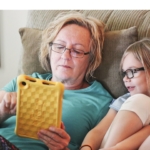
05 Mar How To Read To Kids
Literacy begins with parental involvement – often, reading aloud – and continues with the development of a genuine enjoyment of reading. Books play an essential role in a child’s development and are the building blocks for a better future.
How to read to children
- Take books everywhere and make the most of every minute – in cafes, on public transport, in the car, your office and on visits to the doctor or dentist.
- Read everyday items aloud: labels, cereal boxes, road signs, maps, catalogues, brochures, and so forth.
- Visit the library and ask the librarian to help you find appropriate books for your kids. Show kids how to find books on the topics that interest them.
- Build a home library: charity shops, flea markets and garage sales are all great sources of low-cost books.
- Give books or book vouchers as gifts.
Reading to young children
- Set aside the same time every day to help establish a routine (bedtime, bath time, after school, on the potty or in the sandbox).
- Choose hard-wearing books and let kids touch, chew and play.
- Some kids don’t like to sit still: try letting them draw or play quietly beside you while you read, or get them to help you hold the book and turn the pages.
- Read slowly with lots of expression. Put on silly voices: the more fun your child has, the more they will learn to love books and reading.
- Point to pictures and words and tell them what they are. Follow the text with your finger as you read, discuss the story and ask what comes next (listen to their response): this helps build comprehension skills. Reading To Emergent Readers
- Take turns reading paragraphs or even whole pages.
- Help your child with words they are having trouble with: read it for them so they can keep going or ask them what word would make sense, depending on your child’s level.
- Be encouraging.
- Talk about the book as you read it – ask questions that allow your child to express opinions and listen attentively to their answers.
Reading to older readers
- Read short sections of books or articles aloud to catch your child’s attention – encourage them to read the rest on their own.
- Call their attention to the cover of a book or magazine – ask what they think it’s about it, encourage them to read it and then discuss it with them (read it yourself, too).
- Put a funny article in their lunchbox.
- Encourage your child to read to younger siblings, cousins or family friends.
- Try not to judge: let your child’s interests guide their choice of books. If your child likes poo jokes, put a joke book in the bathroom. If they like electronics and car engines, give them a how-things-work book for their birthday.
Screen time and e-readers
The NSW Government Education and Communities guidelines recommend school-age children have no more than two hours screen time a day (including TV, computer games, tablets and e-readers), while under-twos should have no screen time at all.
Bedtime battles
What happens when your five year old wants one story and your two year old something else? Author Jackie French suggests a weekly chart: Monday, Lily gets to choose; Tuesday it’s Thomas’s turn. Write it down or put a small photo of them on the chart to remind them whose day it is to choose, says Jackie. “You’ll also be teaching them that having the book they love most read to them is a treat to be valued,” she says. “And just sometimes you can make it Mum or Dad’s favourite book, and remind them their parents love books too.”
Words by Anna Gibson








